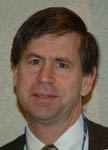Artificial worlds used to unlock secrets of real human interaction
By H. Roger Segelken

DENVER -- What do flocks of birds, traffic jams, fads, drinking games, forest fires and residential segregation have in common? The answer could come from a new computational research method called agent-based modeling.
Michael Macy, a sociologist at Cornell University, Ithaca, N.Y., is using this powerful new tool to look for elementary principles of self-organization that might shed new light on long-standing puzzles about how humans interact. A professor and chair of Cornell's Department of Sociology, Macy will speak Feb. 14 at the annual meeting of the American Association for the Advancement of Science in Denver in a symposium, "Artificial Agent Societies: A Computational Future for the Social Sciences."
The Cornell sociologist begins his lecture with a flock of computer-generated birds wheeling synchronously through aerobatic maneuvers. He credits Craig Reynolds, a pioneer of agent modeling and three-dimensional computer animation, for the 1987 discovery that the complex choreography of a flock requires that each bird (or "boid," as Reynolds called them) follow just three simple rules: head toward the center of your neighbors, match their speed and trajectory and avoid collisions. "Reynolds didn't model the flock as a unitary collective nor did he model isolated birds; he modeled their interactions at the relational level," Macy says. "That's agent-based modeling."
Traditionally, sociologists have tried to understand social life as a structured system of institutions and norms that shape individual behavior from the top down, Macy notes. In contrast, agent modelers suspect that much of social life emerges from the bottom up, more like improvisational jazz than a symphony. For example, many sociologists have attributed residential segregation to the deliberate policies of banks, realtors and public officials responding to popular prejudice. Yet 30 years ago, game theorist Thomas Schelling used one of the first agent-based models to show how extreme segregation tends to emerge even in populations that prefer ethnic diversity, and in the absence of any institutional pressures.
Schelling's model was written long before the invention of the personal computer, using a large checkerboard, with red and blue poker chips to represent a neighborhood's residents. Even 10 years ago agent-based models with large populations might have required hundreds of costly hours on supercomputers; but today's fast and inexpensive desktop machines make this method readily available to social scientists. These models are now being used to show how "simple but predictable local interactions among many individuals can generate familiar but enigmatic social patterns, such as stock market crashes, revolutions, fads and feeding frenzies,"says Macy.
In collaboration with his Cornell colleague David Strang, Macy has used agent-based models to study lemminglike fads among the corporate managers pilloried by Scott Adams in his "Dilbert" comic strip. Contrary to Adams, top managers are highly intelligent and are paid huge salaries to get it right, Macy observes. The Cornell researchers' work, which won the theory prize from the Academy of Management, shows how fads that appear to reflect mindless conformity can be generated by the very opposite -- a single-minded preoccupation with performance and success.
Macy recently was awarded a grant from the National Science Foundation to tackle another familiar puzzle -- peer enforcement of norms that even the enforcers privately question. In collaboration with two Cornell graduate students, Robb Willer and Damon Centola, Macy is using an agent-based model to see how the diffusion and stability of unpopular norms might depend on the size and geometry of peer networks. The father of teenagers, Macy ponders the curious appeal of self-destructive behaviors -- smoking, drinking, drug use, reckless driving, body-piercing and the like. For example, studies of college drinking find that students feel peer pressure to participate in drinking rituals that celebrate intoxication as a symbol of group identity.
"Yet it turns out that students' private beliefs deviate sharply from their perception of the social norm," he notes. "Contrary to campus legend, most students are actually uncomfortable about excessive drinking, at least when they are sober. They do not think drinking games are cool, but they think (incorrectly) that others believe this, and when they join in to secure social approval, their apparent enthusiasm reinforces the illusion that motivates the behavior in others."
When Macy's team tried to generate this dynamic on a computer, the agents always escaped the trap. But then the researchers remembered a lesson taught by Reynolds' boids. "The boids only know about the behavior of their immediate neighbors, and that turns out to be the key to the puzzle," Macy says. "Agents get trapped into enforcing a norm that most of them dislike when their normative expectations are mainly influenced by a small circle of friends."
Media Contact
Get Cornell news delivered right to your inbox.
Subscribe